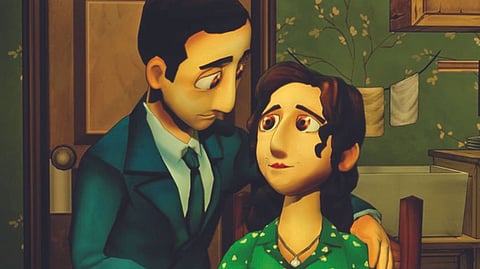

WASHINGTON: Paris, July 1940. A child looks out of a window. People walk by on the street carrying boxes and suitcases. “Are we going to flee?” Samuel asks his parents. “No,” his father replies. “We are going to be brave and stay right here.” Shortly after, Samuel is sent to his room. He listens to his parents talk. “It’s not safe,” he hears his mother say. “We’re as good as dead if we stay here.” “We have nowhere to go,” his father replies. “What choice do we have?” They have no choice. The Jewish family is torn apart. First the father is deported, then the mother and finally the boy. All die in the Auschwitz concentration camp.
The video game, “The Light in the Darkness,” then rolls the closing credits that incorporates black and white photographs of Jewish children who did not survive a Holocaust wherein more than six million Jews were murdered by the Nazis.
“I can’t get over the 6 million dead. I can’t get over it,” Luc Bernard told DW.
“I remember those who died. I am not just reducing them to numbers, because to me they were kind of our families, friends, neighbors and citizens.”
Raised in France and now based in US, the 37-year-old British Jewish game developer created “The Light in the Darkness” almost entirely by himself. It’s a project close to his heart that he’s been carrying around since 2008. But it took almost 15 years before he could finally release the game.
There are so many World War II games, but none about the Holocaust, he says, adding that changing that was his motivation. The rise in antisemitism around the world frightens him, he says. “I think it’s just going to continue to get worse. Unless we change the way we do Holocaust awareness.”
For a long time, it was taboo to depict the horrors of the Nazi-era in a computer game.
Bernard was considered the “Holocaust guy” within the games industry. He did not receive funding or support from NGOs. He put all his own money into the game and still offers it for free.
Only now, after the game has been released, is he receiving encouragement — mainly from Europe, but also from the Israeli government. In the first few weeks after its release, some 100,000 people downloaded his game, he says. The more time that passes since the Holocaust, the more difficult it is to create a social awareness of the mass murder of Jews, says Bernard. He wants to use his game to draw young people’s attention to the subject in particular, arguing for the importance of reaching them with content instead of hoping they will go to museums or visit memorial sites of their own accord. Bernard’s own family history was affected by the Nazi era.
His British grandmother, whose first husband was a German Jew, cared for Jewish children who were brought to safety from Germany to Britain in 1938 and 1939 on the “Kindertransport” (Children’s Transport), an organized rescue effort for children.
“In the video game industry, if I’m honest, as a Jewish person in the gaming industry, Jews don’t really seem to count much in terms of representation. And our history and trauma doesn’t really seem to count much,” says Bernard.
Although World War II has for decades been one of the most popular historical settings for video games, especially in the strategy and first-person shooter genres, these stories are usually told from a military point of view.
Visit news.dtnext.in to explore our interactive epaper!
Download the DT Next app for more exciting features!
Click here for iOS
Click here for Android